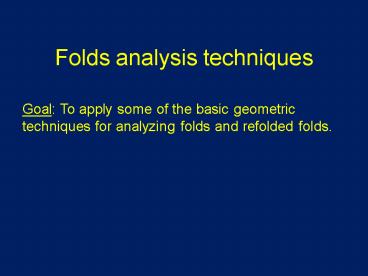Folds analysis techniques PowerPoint PPT Presentation
Title: Folds analysis techniques
1
Folds analysis techniques
Goal To apply some of the basic geometric
techniques for analyzing folds and refolded folds.
2
1. Foliation bedding intersections
- Three cases for overturned fold
- Bedding upright, dipping more shallowly than
foliation - Bedding overturned dipping more steeply than
foliation - Bedding highly oblique to foliation
3
- Note that for cylindrical folds,
bedding-foliation intersection lineation lies
close to fold hinge.
4
2. p-axes and ß-axes
- Define fold axis using measurements of bedding
from around the fold - Plot on stereonet
5
p-girdle best-fit girdle to poles to
beddingp-axis pole to p-girdle
6
Finding p-axes
1. Plot poles to bedding
2. Find best-fit great circle
7
(No Transcript)
8
ß-axis defined by intersections of bedding
planes plotted on net
9
Find a fold axis using these bedding measurements
- 050, 80-SE
- 350, 44-NE
- 088, 72-NW
- Use both p-axis and ß-axis methods
10
3. Refolded folds
11
Refolded folds recognition
- Can often be found in outcrop
- Regional patterns in facing direction
- Interference patterns
12
Interpret these maps Draw in F1 and F2 axes and
indicate plunge directions
13
Steps to interpret maps
- Draw two lines representing fold axes. Which one
is refolded? - Identify pattern of younger and older rocks. e.g.
youngest on outside - Is the hook/boomerang shape a syncline or
anticline? - Decide what kind of fold refolded the first fold.
PowerShow.com is a leading presentation sharing website. It has millions of presentations already uploaded and available with 1,000s more being uploaded by its users every day. Whatever your area of interest, here you’ll be able to find and view presentations you’ll love and possibly download. And, best of all, it is completely free and easy to use.
You might even have a presentation you’d like to share with others. If so, just upload it to PowerShow.com. We’ll convert it to an HTML5 slideshow that includes all the media types you’ve already added: audio, video, music, pictures, animations and transition effects. Then you can share it with your target audience as well as PowerShow.com’s millions of monthly visitors. And, again, it’s all free.
About the Developers
PowerShow.com is brought to you by CrystalGraphics, the award-winning developer and market-leading publisher of rich-media enhancement products for presentations. Our product offerings include millions of PowerPoint templates, diagrams, animated 3D characters and more.

